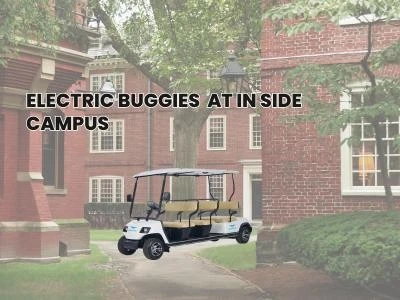Introduction
Electric buggies have emerged as a game-changer in campus transportation, offering universities a sustainable and efficient alternative to traditional shuttles and buses. As the demand for eco-friendly transportation solutions grows, electric buggies are transforming how students, staff, and visitors navigate university campuses. This comprehensive guide will explore the benefits of electric buggies, their impact on campus transportation, and how they contribute to a greener and more sustainable environment.
The Rise of Electric Buggies on Campus
Universities worldwide are increasingly adopting electric buggies as part of their campus transportation solutions. This shift towards electric transportation options is driven by several factors, including the need to reduce carbon emissions, lower operational costs, and provide a quieter, more pleasant transportation experience. Notable universities, such as Stanford, Harvard, and UC Berkeley, are leading the way in electric buggy implementation, showcasing the potential of these vehicles to revolutionize campus mobility.
However, the use of electric buggies is not limited to university campuses. These versatile vehicles are also popular in a variety of other settings, such as:
- Hotels and Resorts: Providing guests with convenient and eco-friendly transportation around large properties.
- Hospitals: Facilitating the movement of patients, visitors, and staff across extensive hospital campuses.
- Temples and Religious Sites: Offering pilgrims and visitors a comfortable way to navigate large spiritual complexes.
- Airports and Railway Stations: Assisting passengers with their luggage and ensuring smooth transfers within the premises.
- Tourist Attractions: Enhancing the visitor experience by offering easy access to different areas of large tourist sites.
- Parks and Zoos: Helping visitors cover more ground effortlessly while enjoying the attractions.
- Factories and Warehouses: Streamlining the transportation of goods and personnel within large industrial complexes.
- Theme Parks: Providing guests with a convenient way to explore extensive amusement parks.
- Industrial Estates and Tech Parks: Ensuring efficient transportation within sprawling business districts.
Advantages of Electric Buggies for Campus Transportation
Electric buggies offer numerous benefits over traditional campus shuttles, making them an attractive option for universities:
Environmental Benefits:
- Reduced Carbon Emissions: Electric buggies produce zero emissions, helping universities lower their carbon footprint and contribute to a cleaner environment.
- Lower Noise Pollution: Unlike gas-powered vehicles, electric buggies operate quietly, reducing noise pollution on campus and creating a more serene atmosphere.
Cost-Effectiveness:
- Lower Operational Costs: Electric buggies are cheaper to operate and maintain compared to traditional shuttles. They require less frequent servicing and have fewer moving parts, leading to lower maintenance costs.
- Energy Efficiency: Electric golf carts are more energy-efficient, which translates into cost savings on fuel and energy consumption.
Operational Efficiency:
- Compact and Maneuverable: Electric buggies are smaller and more maneuverable than traditional shuttles, making them ideal for navigating narrow pathways and crowded areas on campus.
- Flexible Scheduling: These buggies can be deployed on-demand, providing more flexible and responsive transportation solutions for students and staff.
Addressing Common Questions and Concerns
How do electric buggies benefit campus transportation? Electric buggies offer a sustainable and efficient alternative to traditional shuttles, reducing carbon emissions, lowering operational costs, and providing a quieter transportation experience.
What are the advantages of using electric buggies on campus? Advantages include environmental benefits, cost-effectiveness, and operational efficiency. Electric buggies reduce carbon emissions and noise pollution, have lower operational costs, and are more maneuverable than traditional shuttles.
How are electric buggies different from traditional campus shuttles? Electric buggies are smaller, quieter, and more energy-efficient. They produce zero emissions and are cheaper to operate and maintain compared to traditional gas-powered shuttles.
Are electric buggies cost-effective for universities? Yes, electric buggies are cost-effective due to their lower operational and maintenance costs. They also offer savings on fuel and energy consumption.
What factors contribute to the popularity of electric buggies on campus? Factors include environmental benefits, cost savings, operational efficiency, and the growing demand for sustainable transportation options.
How can universities ensure the efficient operation of electric buggy fleets? Universities can ensure efficient operation by investing in robust charging infrastructure, scheduling regular maintenance, and utilizing fleet management software to monitor and optimize buggy usage.
Future Outlook and Opportunities
The future of electric buggies on university campuses looks promising, with potential for further expansion and technological advancements. Universities are encouraged to continue investing in sustainable transportation solutions and explore new developments in electric vehicle technology and infrastructure. Future opportunities include the integration of renewable energy sources for charging stations, the use of autonomous electric buggies, and the development of smart campus transportation systems.
Conclusion
Electric buggies are transforming campus transportation by offering a sustainable, cost-effective, and efficient alternative to traditional shuttles. Their adoption represents a significant step towards greener and more eco-friendly campus transportation solutions. As universities continue to prioritize sustainability and innovation, electric buggies will play a crucial role in shaping the future of campus mobility. Readers are encouraged to learn more about electric buggies and advocate for their implementation in their respective institutions, contributing to a cleaner and more sustainable environment.


